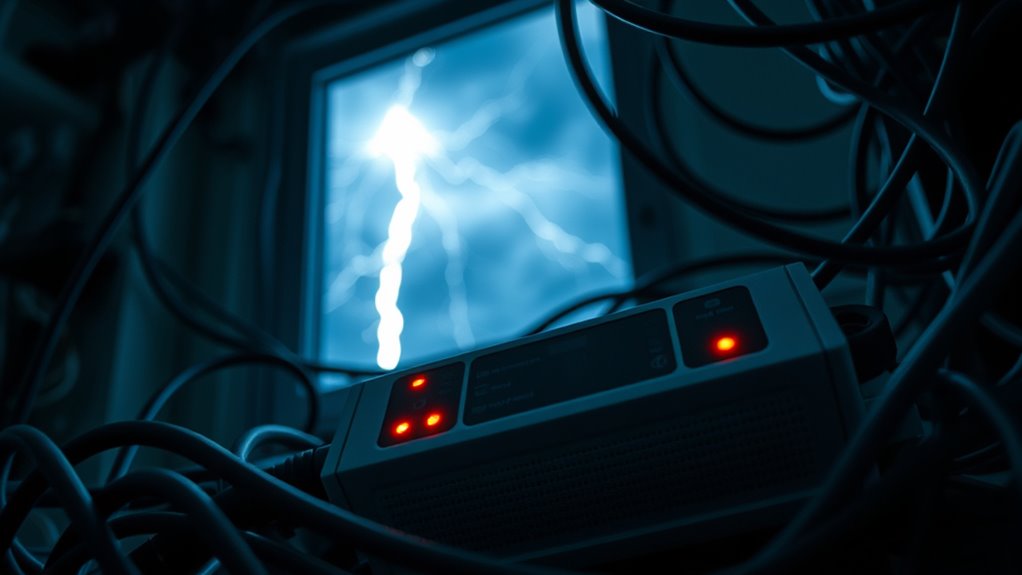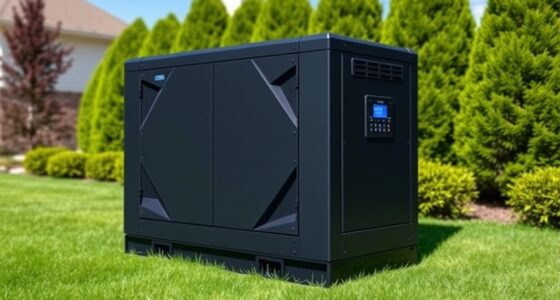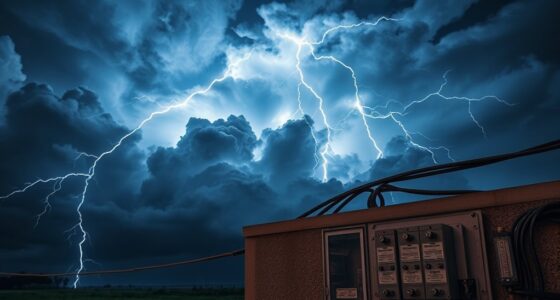Lightning and surge calculators provide estimates but often miss hidden costs like property damage, downtime, and secondary repairs. These tools rely on limited data and assumptions, which can lead to underestimated expenses, especially when regional storm patterns or outdated information aren’t considered. To avoid surprises, you need thorough risk assessments and proper mitigation strategies. Keep exploring to discover practical ways to improve your lightning protection and avoid costly hidden expenses.
Key Takeaways
- Hidden costs include property damage, downtime, secondary damages, and insurance gaps often overlooked in initial estimates.
- Lightning and surge calculators rely on data quality; outdated or simplified info can underestimate risks and expenses.
- Secondary damages like fires or mold can significantly inflate repair costs beyond initial surge protection assessments.
- Regular inspections, proper grounding, and high-quality surge protectors help mitigate hidden costs and reduce damage severity.
- Keeping detailed records and performing routine risk assessments improve cost accuracy and help avoid unexpected expenses.
How Lightning and Surge Calculators Work and Their Limitations

Lightning and surge calculators analyze environmental data and electrical system parameters to estimate the risk of damage from electrical surges. They assess lightning risks based on factors like storm frequency, proximity, and historical data, helping you understand potential threats. These tools also evaluate surge protection levels, indicating whether your current systems can handle sudden voltage spikes. However, their accuracy depends on the quality of input data and assumptions made about local conditions. They don’t always account for unexpected variables or hidden vulnerabilities, which can lead to underestimated risks. Additionally, the effectiveness of these calculators can be impacted by model limitations, such as outdated data or simplified assumptions. While surge calculators are valuable for planning, don’t rely solely on them. Proper surge protection, regular maintenance, and expert advice are essential to truly safeguard your electrical system from lightning-related damage and hidden costs.
Common Hidden Costs That Can Escape Initial Estimates

Even with thorough initial assessments, some costs related to lightning and surge damage can catch you off guard. Costly oversights often stem from hidden expenses that aren’t immediately obvious. For example, repairs might extend beyond replacing damaged equipment, including costs for property restoration or infrastructure upgrades. Unexpected downtime can lead to productivity losses that weren’t factored in initially. Additionally, secondary damages—like electrical fires or mold from water used in repairs—can add up quickly. Insurance claims may not cover all expenses, leaving you to foot the bill for overlooked issues. Emerging technology risks associated with lightning protection systems can also contribute to unforeseen expenses. These hidden costs can considerably inflate your total expenses, making it essential to account for potential surprises during planning. Being aware of these common hidden costs helps you prepare better and avoid expensive surprises later.
Factors That Skew Calculator Accuracy and Underestimate Expenses

Many factors can cause lightning and surge damage cost calculators to fall short, leading to underestimated expenses. These miscalculations often stem from overlooked risks and incomplete data. For example, some risks aren’t immediately obvious, like secondary damage or hidden wiring issues. Additionally, calculators may ignore variables such as equipment age or regional storm frequency, skewing results. Here’s a quick look at key factors:
| Factor | Impact |
|---|---|
| Overlooked risks | Underestimate true costs |
| Outdated data | Miss recent storm patterns |
| Equipment age | Older gear incurs higher repair costs |
| Regional variability | Storm intensity differs by location |
| Secondary damage | Hidden damages inflate expenses |
Being aware of storm intensity variations and other unpredictable factors can help improve accuracy and prevent costly surprises.
Practical Strategies to Accurately Assess and Mitigate Risks
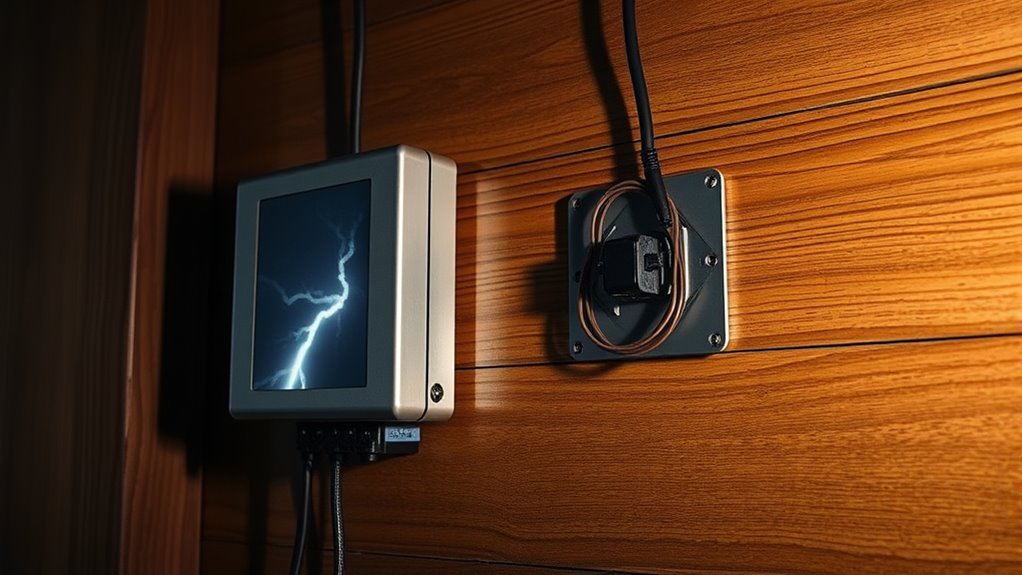
To effectively manage lightning and surge risks, you need practical strategies that guarantee accurate assessment and proactive mitigation. Start by conducting regular site inspections and investing in reliable surge protection devices to prevent damage. Accurate risk assessments help you avoid underestimated expenses that could lead to higher insurance premiums over time. Implement routine maintenance checks on your electrical systems to identify vulnerabilities early, reducing unexpected repair costs. Keep detailed records of all inspections and repairs to support insurance claims and demonstrate proactive risk management. Additionally, educate your team about lightning safety protocols to minimize damage and repair costs. Incorporating spiritual awareness into your safety practices can also promote a more mindful and attentive approach to potential hazards. By staying vigilant and applying these strategies, you can better control maintenance costs and avoid surprises that inflate your overall risk exposure.
Best Practices for Preventing Unexpected Lightning and Surge Damages
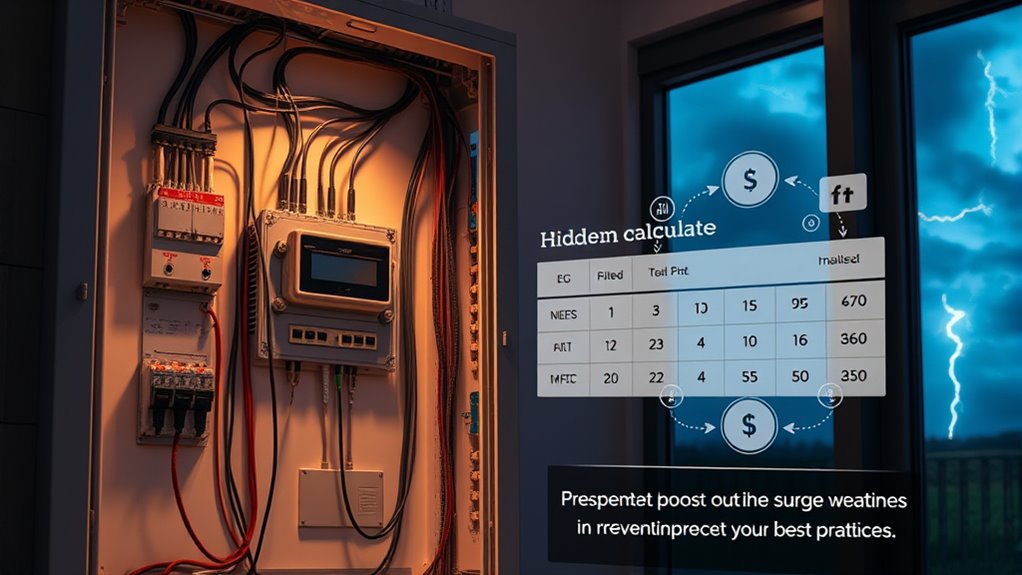
Implementing best practices to prevent unexpected lightning and surge damages can considerably reduce your risk of costly repairs and downtime. Start by addressing grounding issues; ensure your system’s grounding is solid and compliant with standards to effectively redirect surges away from your equipment. Regularly inspect and maintain grounding connections to prevent deterioration. Additionally, verify equipment compatibility with surge protection devices (SPDs) before installation, ensuring they match your system’s voltage and current requirements. Use high-quality surge suppressors rated for your specific environment, and install them at key entry points. Educate yourself on proper wiring and grounding techniques to avoid common pitfalls. Proper environmental considerations also play a role in surge prevention, such as minimizing exposure to lightning-prone areas or using protective enclosures. By proactively managing grounding issues and confirming equipment compatibility, you create a robust defense against lightning-induced surges and protect your assets efficiently.
Frequently Asked Questions
How Often Should Lightning and Surge Risk Assessments Be Updated?
You should update your lightning and surge risk assessments at least annually, aligning with your maintenance schedules. Regular updates guarantee your system stays protected against evolving threats. Additionally, involve technician training during these updates to keep your team informed about recent risks and mitigation strategies. This proactive approach minimizes vulnerabilities, saves costs, and maintains your system’s safety and efficiency over time.
Can Weather Patterns Change Impact Calculator Accuracy Over Time?
Coincidences like unexpected weather shifts remind you that climate variability can impact your calculator’s accuracy over time. As weather patterns change unpredictably, your predictive modeling needs regular updates to stay reliable. When climate variability influences storm frequency or intensity, your risk assessments may become outdated. Stay proactive by periodically revising your calculator, ensuring it reflects current conditions and maintains the precision needed for effective lightning and surge risk management.
What Are the Long-Term Costs of Ignoring Surge Protection?
Ignoring surge protection can lead to costly equipment damage and extended business downtime. Without proper safeguards, lightning strikes or power surges can fry sensitive electronics, forcing expensive repairs or replacements. Additionally, unexpected outages may halt operations, resulting in lost revenue and decreased productivity. Over time, these costs add up considerably, making surge protection a wise investment to prevent long-term financial setbacks and ensure your business stays resilient against electrical threats.
How Do Different Electrical Systems Influence Surge Vulnerability?
You influence surge vulnerability through your electrical systems by ensuring proper grounding practices and ideal wiring configurations. Poor grounding can increase the risk of surges, while outdated or incorrect wiring setups might not handle power fluctuations effectively. By maintaining proper grounding and updating wiring configurations, you reduce your system’s susceptibility to surges, protecting your devices and avoiding hidden costs associated with damage. Regular inspections help keep your system resilient against electrical surges.
Are There Specific Industries More Prone to Hidden Surge-Related Costs?
Think of certain industries as fragile glassware, more prone to shattering from unseen shocks. You’ll find industries like data centers, manufacturing, and healthcare most vulnerable to hidden surge-related costs due to industry-specific vulnerabilities. Regional surge risks amplify this danger, turning local electrical storms into costly battles. If you’re in these sectors, you need vigilant surge protection to prevent hidden expenses from quietly creeping in and causing chaos.
Conclusion
By understanding how lightning and surge calculators work, recognizing their limitations, and identifying hidden costs, you can make smarter decisions. You’ll avoid surprises, save money, and protect your equipment. You’ll assess risks more accurately, plan better defenses, and prevent unexpected damages. With these strategies, you’ll stay prepared, stay secure, and stay ahead—turning complex calculations into confident choices that keep your systems safe and your costs under control.
